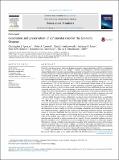Generation and preservation of continental crust in the Grenville Orogeny
Abstract
Detrital zircons from modern sediments display an episodic temporal distribution of U-Pb crystallization ages forming a series of 'peaks' and 'troughs'. The peaks are interpreted to represent either periods of enhanced generation of granitic magma perhaps associated with mantle overturn and superplume events, or preferential preservation of continental crust during global collisional orogenesis. The close association of those peaks with the assembly of supercontinents implies a causal relationship between collisional orogenesis and the presence of zircon age peaks. Here these two end-member models (episodic periodicity of increased magmatism versus selective preservation during collisional orogenesis) are assessed using U-Pb, Hf, and O analysis of detrital zircons from sedimentary successions deposited during the ∼1.3-1.1 Ga accretionary, ∼1.1-0.9 Ga collisional, and <0.9 Ga extensional collapse phases of the Grenville orogenic cycle in Labrador and Scotland. The pre-collisional, accretionary stage provides a baseline of continental crust present prior to orogenesis and is dominated by Archean and Paleoproterozoic age peaks associated with pre-1300 Ma Laurentian geology. Strata deposited during the Grenville Orogeny display similar Archean and Paleoproterozoic detrital populations along with a series of broad muted peaks from ∼1500 to 1100 Ma. However, post-collisional sedimentary successions display a dominant age peak between 1085 and 985 Ma, similar to that observed in modern North American river sediments. Zircons within the post-orogenic sedimentary successions have progressively lower εHf and higher δ18O values from ∼1800 to ∼1200 Ma whereupon they have higher εHf and δ18O within the dominant 1085-985 Ma age peak. Furthermore, the Lu-Hf isotopic profile of the Grenville-related age peak is consistent with significant assimilation and contamination by older crustal material. The timing of this dominant age peak coincides with the peak of metamorphism and magmatism associated with the Grenville Orogeny, which is a typical collisional orogenic belt. The change from broad muted age peaks in the syn-orogenic strata to a single peak in the post-orogenic sedimentary successions and in the modern river sediments implies a significant shift in provenance following continental collision. This temporal change in provenance highlights that the source(s), from which detrital zircons within syn-orogenic strata were derived, was no longer available during the later stages of the accretionary and collisional stages of the orogenic cycle. This may reflect some combination of tectonic burial, erosion, or possibly recycling into the mantle by tectonic erosion of the source(s). During continental collision, the incorporated continental crust is isolated from crustal recycling processes operative at subduction margins. This tectonic isolation combined with sedimentary recycling likely controls the presence of the isotopic signature associated with the Grenville Orogeny in the modern Mississippi and Appalachian river sediments. These results imply that zircon age peaks, which developed in conjunction with supercontinents, are the product of selective crustal preservation resulting from collisional orogenesis.
Citation
Spencer , C J , Cawood , P A , Hawkesworth , C J , Prave , A R , Roberts , N M W , Horstwood , M S A & Whitehouse , M J 2015 , ' Generation and preservation of continental crust in the Grenville Orogeny ' , Geoscience Frontiers , vol. 6 , no. 3 , pp. 357-372 . https://doi.org/10.1016/j.gsf.2014.12.001
Publication
Geoscience Frontiers
Status
Peer reviewed
ISSN
1674-9871Type
Journal article
Collections
Items in the St Andrews Research Repository are protected by copyright, with all rights reserved, unless otherwise indicated.

